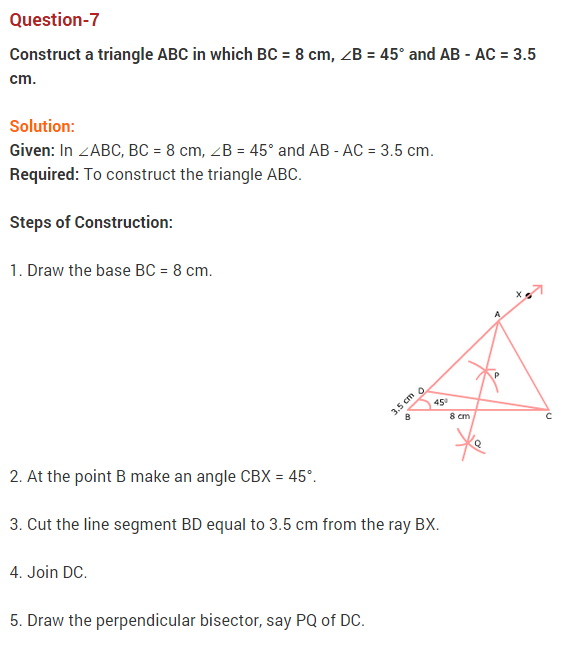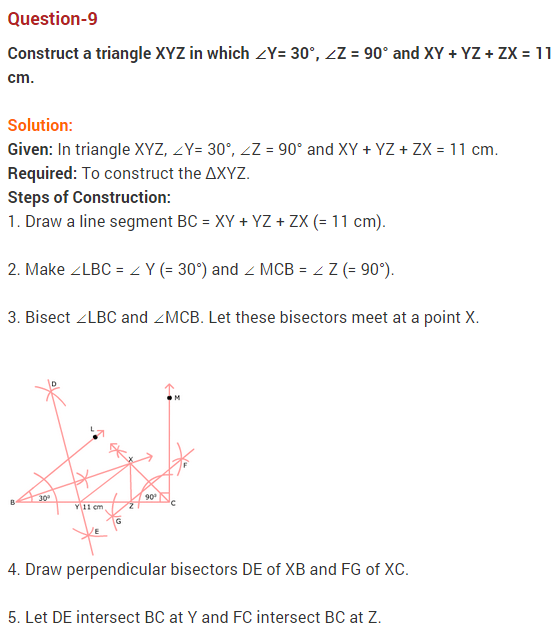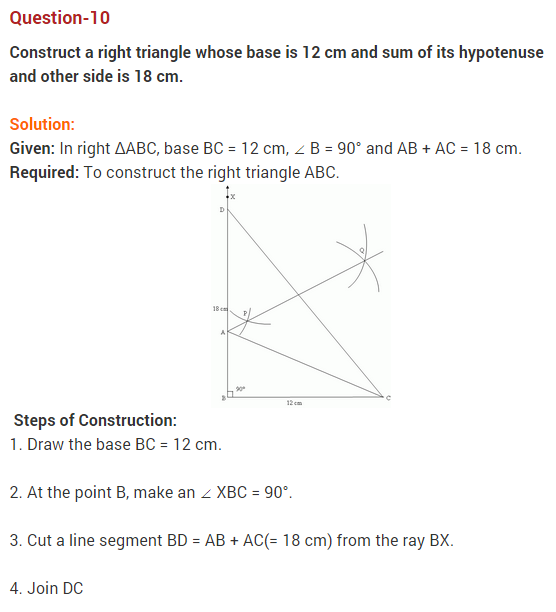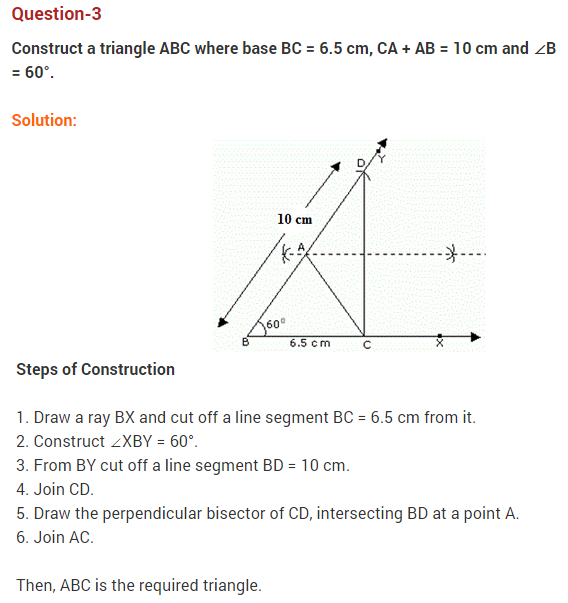NCERT Solutions for Class 9 Maths Chapter 11 Constructions
NCERT Solutions for Class 9 Maths Chapter 11 Constructions Ex 11.1
Ex 11.1 Class 9 Maths Question 1.
Construct an angle of 90° at the initial point of a given ray and justify the construction.
Solution:
Steprf of Construction:
Step I : Draw AB¯¯¯¯¯¯¯¯.
Step II : Taking O as centre and having a suitable radius, draw a semicircle, which cuts OA¯¯¯¯¯¯¯¯ at B.
Step III : Keeping the radius same, divide the semicircle into three equal parts such that BC˘=CD˘=DE˘ .
Step IV : Draw OC¯¯¯¯¯¯¯¯ and OD¯¯¯¯¯¯¯¯.
Step V : Draw OF¯¯¯¯¯¯¯¯, the bisector of ∠COD.

Thus, ∠AOF = 90°
Justification:
∵ O is the centre of the semicircle and it is divided into 3 equal parts.
∴ \breve { BC } =\quad \breve { CD } \quad =\quad \breve { DE }
BC˘=CD˘=DE˘
⇒ ∠BOC = ∠COD = ∠DOE [Equal chords subtend equal angles at the centre]
And, ∠BOC + ∠COD + ∠DOE = 180°
⇒ ∠BOC + ∠BOC + ∠BOC = 180°
⇒ 3∠BOC = 180°
⇒ ∠BOC = 60°
Similarly, ∠COD = 60° and ∠DOE = 60°
∵ OF¯¯¯¯¯¯¯¯ is the bisector of ∠COD
∴ ∠COF = 1/2 ∠COD = 1/2 (60°) = 30°
Now, ∠BOC + ∠COF = 60° + 30°
⇒ ∠BOF = 90° or ∠AOF = 90°
Ex 11.1 Class 9 Maths Question 2.
Construct an angle of 45° at the initial point of a given ray and justify the construction.
Solution:
Steps of Construction:
Stept I : Draw OA¯¯¯¯¯¯¯¯.
Step II : Taking O as centre and with a suitable radius, draw a semicircle such that it intersects OA¯¯¯¯¯¯¯¯. at B.
Step III : Taking B as centre and keeping the same radius, cut the semicircle at C. Now, taking C as centre and keeping the same radius, cut the semicircle at D and similarly, cut at E, such that BC˘=CD˘=DE˘
Step IV : Draw OC¯¯¯¯¯¯¯¯ and OD¯¯¯¯¯¯¯¯.
Step V : Draw OF¯¯¯¯¯¯¯¯, the angle bisector of ∠BOC.
Step VI : Draw OG¯¯¯¯¯¯¯¯, the ajngle bisector of ∠FOC.

Thus, ∠BOG = 45° or ∠AOG = 45°
Justification:
∵ BC˘=CD˘=DE˘
∴ ∠BOC = ∠COD = ∠DOE [Equal chords subtend equal angles at the centre]
Since, ∠BOC + ∠COD + ∠DOE = 180°
⇒ ∠BOC = 60°
∵ OF¯¯¯¯¯¯¯¯ is the bisector of ∠BOC.
∴ ∠COF = 1/2 ∠BOC = 1/2(60°) = 30° …(1)
Also, OG¯¯¯¯¯¯¯¯ is the bisector of ∠COF.
∠FOG = 1/2∠COF = 1/2(30°) = 15° …(2)
Adding (1) and (2), we get
∠COF + ∠FOG = 30° + 15° = 45°
⇒ ∠BOF + ∠FOG = 45° [∵ ∠COF = ∠BOF]
⇒ ∠BOG = 45°
Ex 11.1 Class 9 Maths Question 3.
Construct the angles of the following measurements
(i) 30°
(ii) 22 1/2∘
(iii) 15°
Solution:
(i) Angle of 30°
Steps of Construction:
Step I : Draw OA¯¯¯¯¯¯¯¯.
Step II : With O as centre and having a suitable radius, draw an arc cutting OA¯¯¯¯¯¯¯¯ at B.
Step III : With centre at B and keeping the same radius as above, draw an arc to cut the previous arc at C.
Step IV : Join OC¯¯¯¯¯¯¯¯ which gives ∠BOC = 60°.
Step V : Draw OD¯¯¯¯¯¯¯¯, bisector of ∠BOC, such that ∠BOD = 1/2∠BOC = 1/2(60°) = 30°

Thus, ∠BOD = 30° or ∠AOD = 30°
(ii) Angle of 22 1/2∘
Steps of Construction:
Step I : Draw OA¯¯¯¯¯¯¯¯.
Step II : Construct ∠AOB = 90°
Step III : Draw OC¯¯¯¯¯¯¯¯, the bisector of ∠AOB, such that
∠AOC = 1/2∠AOB = 1/2(90°) = 45°
Step IV : Now, draw OD, the bisector of ∠AOC, such that
∠AOD = 1/2∠AOC = 1/2(45°) = 22 1/2∘

Thus, ∠AOD = 22 1/2∘
(iii) Angle of 15°
Steps of Construction:
Step I : Draw OA¯¯¯¯¯¯¯¯.
Step II : Construct ∠AOB = 60°.
Step III : Draw OC, the bisector of ∠AOB, such that
∠AOC = 1/2∠AOB = 1/2(60°) = 30°
i.e., ∠AOC = 30°
Step IV : Draw OD, the bisector of ∠AOC such that
∠AOD = 1/2∠AOC = 1/2(30°) = 15°

Thus, ∠AOD = 15°
Ex 11.1 Class 9 Maths Question 4.
Construct the following angles and verify by measuring them by a protractor
(i) 75°
(ii) 105°
(iii) 135°
Solution:
Step I : Draw OA¯¯¯¯¯¯¯¯.
Step II : With O as centre and having a suitable radius, draw an arc which cuts OA¯¯¯¯¯¯¯¯ at B.
Step III : With centre B and keeping the same radius, mark a point C on the previous arc.
Step IV : With centre C and having the same radius, mark another point D on the arc of step II.
Step V : Join OC¯¯¯¯¯¯¯¯ and OD¯¯¯¯¯¯¯¯, which gives ∠COD = 60° = ∠BOC.
Step VI : Draw OP¯¯¯¯¯¯¯¯, the bisector of ∠COD, such that
∠COP = 1/2∠COD = 1/2(60°) = 30°.
Step VII: Draw OQ¯¯¯¯¯¯¯¯, the bisector of ∠COP, such that
∠COQ = 1/2∠COP = 1/2(30°) = 15°.

Thus, ∠BOQ = 60° + 15° = 75°∠AOQ = 75°
(ii) Steps of Construction:
Step I : Draw OA¯¯¯¯¯¯¯¯.
Step II : With centre O and having a suitable radius, draw an arc which cuts OA¯¯¯¯¯¯¯¯ at B.
Step III : With centre B and keeping the same radius, mark a point C on the previous arc.
Step IV : With centre C and having the same radius, mark another point D on the arc drawn in step II.
Step V : Draw OP, the bisector of CD which cuts CD at E such that ∠BOP = 90°.
Step VI : Draw OQ¯¯¯¯¯¯¯¯, the bisector of BC˘ such that ∠POQ = 15°

Thus, ∠AOQ = 90° + 15° = 105°
(iii) Steps of Construction:
Step I : Draw OP¯¯¯¯¯¯¯¯.
Step II : With centre O and having a suitable radius, draw an arc which cuts OP¯¯¯¯¯¯¯¯ at A
Step III : Keeping the same radius and starting from A, mark points Q, R and S on the arc of step II such that AQ˘=QR˘=RS˘ .
StepIV :Draw OL¯¯¯¯¯¯¯, thebisector of RS˘ which cuts the arc RS˘ at T.
Step V : Draw OM¯¯¯¯¯¯¯¯¯, the bisector of RT˘.

Thus, ∠POQ = 135°
Ex 11.1 Class 9 Maths Question 5.
Construct an equilateral triangle, given its side and justify the construction.
Solution:
pt us construct an equilateral triangle, each of whose side = 3 cm(say).
Steps of Construction:
Step I : Draw OA¯¯¯¯¯¯¯¯.
Step II : Taking O as centre and radius equal to 3 cm, draw an arc to cut OA¯¯¯¯¯¯¯¯ at B such that OB = 3 cm
Step III : Taking B as centre and radius equal to OB, draw an arc to intersect the previous arc at C.
Step IV : Join OC and BC.

Thus, ∆OBC is the required equilateral triangle.
Justification:
∵ The arcs OC˘ and BC˘ are drawn with the same radius.
∴ OC˘ = BC˘
⇒ OC = BC [Chords corresponding to equal arcs are equal]
∵ OC = OB = BC
∴ OBC is an equilateral triangle.
NCERT Solutions for Class 9 Maths Chapter 11 Constructions Ex 11.2










Constructions Class 9 Extra Questions Maths Chapter 11
Extra Questions for Class 9 Maths Chapter 11 Constructions














IMPORTANT QUESTIONS
VERY SHORT ANSWER TYPE QUESTIONS
1. Construct an angle of 90° at the initial point of the given ray. [CBSE-15-6DWMW5A]
Answer.

2. Draw a line segment PQ = 8.4 cm. Divide PQ into four equal parts using ruler and compass. [CBSE-14-ERFKZ8H], [CBSE – 14-GDQNI3W], [CBSE-14-17DIG1U]
Answer. Steps of construction :
- Draw a line segment PQ = 8.4 cm.
- With P and Q as centres, draw arcs of radius little more than half of PQ. Let his line intersects PQ in M.
- With M and Q as centres, draw arcs of radius little more than half of MQ. Let this line intersects PQ in N.
- With P and M as centres, draw arcs of radius little more than half of PM. Let this line intersects PQ in L. Thus, L, M and N divide the line segment PQ in four equal parts.

3. Draw any reflex angle. Bisect it using compass. Name the angles so obtained. [CBSE-15-NS72LP7]
Answer.

4. Why we cannot construct a ΔABC, if ∠A=60°, AB — 6 cm, AC + BC = 5 cm but construction of A ABC is possible if ∠A=60°, AB = 6 cm and AC – BC = 5 cm. [CBSE-14-GDQNI3W]
Answer. We know that, by triangle inequality property, construction of triangle is possible if sum of two sides of a triangle is greater than the third side.
Here, AC + BC = 5 cm which is less than AB ( 6 cm)
Thus, ΔABC is not possible.
Also, by triangle inequality property, construction of triangle is possible, if difference of two
sides of a triangle is less than the third side
Here, AC – BC = 5 cm, which is less than AB (6 cm)
Thus, ΔABC is possible.
5. Construct angle of [52 1/2]0 using compass only. [CBSE-14-17DIG1U]
Answer.

SHORT ANSWER QUESTIONS TYPE-I
6. Using ruler and compass, construct 4∠XYZ, if ∠XYZ= 20° [CBSE-14-ERFKZ8H]
Answer.

7. Construct an equilateral triangle LMN, one of whose side is 5 cm. Bisect ∠ M of the triangle. [CBSE March 2012]
Answer. Steps of construction :
- Draw a line segment LM = 5 cm.
- Taking L as centre and radius 5 cm draw an arc.
- Taking M as centre and radius draw an other arc intersecting previous arc at N.
- Join LN and MN. Thus, ΔLMN is the required equilateral triangle.
- Taking M as centre and any suitable radius, draw an arc intersecting LM at P and MN at Q.
- Taking P and Q as centres and same radii, draw arcs intersecting at S.
- Join MS and produce it meet LN at R. Thus, MSR is the required bisector of ∠M.

SHORT ANSWER QUESTIONS TYPE-II
8. Construct a A ABC with BC = 8 cm, ∠B= 45° and AB – AC = 3.1 cm. [CBSE-15-NS72LP7]
Answer.

9. Construct an isosceles triangle whose two equal sides measure 6 cm each and whose base is 5 cm. Draw the perpendicular bisector of its base and show that it passes through the opposite vertex [CBSE-15-6DWMW5A]
Answer. Steps of construction :
- Draw a line segment AB = 5 cm.
- With A and B as centres, draw two arcs of radius 6 cm and let they intersect each other in C.
- Join AC and BC to get ΔABC.
- With A and B as centres, draw two arcs of radius little more than half of AB. Let they intersect each other in P and Q. Join PQ and produce, to pass through C.

10. Construct a right triangle whose base is 8 cm and sum of the hypotenuse and other side is 16 cm.
Answer. Given : In ΔABC, BC = 8 cm, ∠B= 90° and AB + AC = 16 cm.
Required : To construct ΔABC.
Steps of construction:
- Draw a line segment BC = 8 cm.
- At B, Draw ∠CBX = 90°.
- From ray BX, cut off BE = 16 cm.
- Join CE .
- Draw the perpendicular bisector of EC meeting BE at A.
- Join AC to obtain the required ΔABC.

11. To construct an isosceles ΔABC in which base BC = 4 cm, sum of the perpendicular from A to BC and side AB = 6.5 cm.
Answer. Given : In ΔABC, BC = 4 cm and sum of the perpendicular from A to BC and side AB = 6.5 cm.
Required : To construct ΔABC.
Steps of construction :
- Draw any line segment BC = 4 cm.
- Draw ‘p’ the perpendicular bisector of BC and let it intersect BC in R
- Cut off PQ = 6.5 cm.
- Join QB.
- Draw the perpendicular bisector of BQ and let it intersect PQ in A.
- Join AB and AC. Thus, ΔABC is the required triangle.

12. Construct an equilateral triangle of altitude 6 cm. [CBSE-15-6DWMW5A]
Answer. Steps of construction :
- Draw any line l.
- Take any point M on it and draw a line p perpendicular to l.
- With M as centre, cut off MC = 6 cm
- At C, with initial line CM construct angles of measures 30° on both sides and let these lines intersect line l in A and B. Thus, ΔABC is the required triangle.

13. Draw a line segment QR = 5 cm. Construct perpendiculars at point Q and R to it. Name them as QX and RY respectively. Are they both parallel ? [CBSE-15-NS72LP7] [CBSE-14-ERFKZ8H]
Answer. Steps of construction :
- Draw a line segment QR = 5 cm.
- With Q as centre, construct an angle of 90° and let this line through Q is QX.
- With R as centre, construct an angle of 90° and let this line through R is RY. Yes, the perpendicular lines QX and- RY are parallel.

LONG ANSWER TYPE QUESTIONS
14. Construct a triangle ABC in which BC = 4.7 cm, AB + AC = 8.2 cm and ∠C = 60°. [CBSE March 2012]
Answer. Given : In ΔABC, BC= 4.7 cm, AB + AC = 8.2 cm and ∠C= 60°.
Required : To construct ΔABC.

15. To construct a triangle, given its perimeter and its two base angles, e.g., construct a triangle with perimeter 10 cm and base angles 60° and 45°. [CBSE March 2012]
Answer.

16. Construct ΔXYZ, if its perimeter is 14 cm, one side of length 5 cm and ∠X= 45°. [CBSE-14-ERFKZ8H]
Answer. Here, perimeter of ΔXYZ = 14 cm and one side XY = 5 cm
.-. YZ + XZ = 14 – 5 = 9 cm and ∠X = 45°.
Steps of construction :
- Draw a line segment XY = 5 cm.
- Construct an ∠YXA = 45° with the help of compass and ruler.
- From ray XA, cut off XB – 9 cm.
- Join BY.
- Draw perpendicular bisector of BY and let it intersect XB in Z.
- Join ZY. Thus, ΔXYZ is the required triangle.

